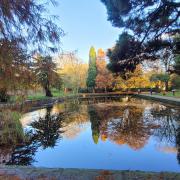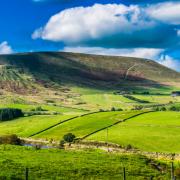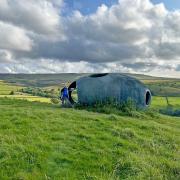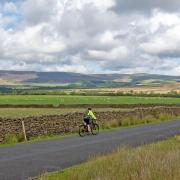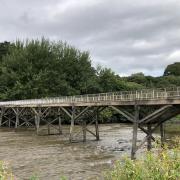Keith Carter leads a walk through the countryside around Calder Vale

Calder Vale sits in a valley bottom, a natural place for a settlement to make use of the water power available to drive first the water wheels then the machinery needed to operate looms. You don’t need to ask why here? The ready supply of natural water has been superseded by mains supply and electricity and the lodges, leats and sluices previously essential are now disused and abandoned.
The first mill was built here in 1835 and today its successor, Lappet Mill, produces essentially the same product, woven cloth although for a very different purpose. Today the mill is exclusively producing Arab head shawls or ‘shermaghs’ the ideal way of protecting the head from sun and wind in the desert, in recent years adopted by young people as a fashion accessory particularly in Japan and the USA.
In a relatively isolated spot such as this, parking is in short supply. What isn’t in use by residents is taken full time by workers in the mill so walkers are not encouraged to fill an empty space if they happen to find one. Instead, don’t take the car down the hill into the lower village but leave it in the sports club car park on the left as you approach the first row of houses. Our walk this month starts here.
Walk past the war memorial, a reminder that even a small community like this sent its quota of men away to do their bit in two World Wars, the names of those who never returned inscribed for future generations to honour. This was no ‘thankful village’, Arkholme and Nether Kellet being the only two villages in Lancashire where every man who went to war, returned. The road descends towards the village but we leave it at a footpath on the left from where a flight of stone steps climbs up a bank, levelling out at the top to enter an enclosed lane running behind houses. This path makes its way crossing stiles and one footbridge then emerges at a road beside the Lancashire Racing Stables.

Cross the road to a stile nearly opposite, then the gallops where the racehorses are trained and enter a rough paddock, keeping along the left-hand boundary through two fields with a lone wind turbine over to the right. Crest a brow and pause to take in the fine view to the west, including the scattered conurbation of Garstang, the M6, the River Wyre and the broad coastal plain stretching to the blue line of the sea in the distance.
We descend the hill to Heald Farm where we had to wait while the farmer and his wife sorted out the lambs for market. They had lost two bulls recently, one from a stroke, the other from catching ‘his bits’ on some barbed wire. The trials of the farming life! As walkers we are outsiders really, passing through working farms without adding anything to the daily round. Leave the farmyard by a stile on the right that leads through an overgrown paddock to cut off the corner and meet the farm access lane where we go right and walk downhill to join a road at a bend with a cottage on the corner.
Keep left then straight on, joining Parkhead Lane for a while. At the end of the lane the tarmac runs out by the stone gateposts of Beesley’s Farm and we continue on the gravel track for a further 50 yards to find a stile on the left half hidden in a holly hedge. This brings us onto a green way enclosed on both sides and at a gate way we are confronted by the M6 a field away and we follow paths parallel with it for the next part of the walk.
Keep the boundary hedge on your left and on reaching a wood, enter it by a stile and go through the trees, over a footbridge and out into a field by another stile. Looking ahead you see a large barn and the right of way goes to the left of it where a stile is concealed in a hedge. Cross a lane to the farm on the right where they breed Welsh Cobs then continue across two fields one with a footbridge across a stream and join a further lane at Lees Farm.

Turn right and walk along the lane as far as a junction then turn right, cross a bridge over the motorway and on the far side is the Kenlis Arms pub. But be warned – they don’t open at lunchtime Mondays, Tuesdays or Wednesdays. Just our luck to arrive on a Tuesday! Retrace your steps to the junction and keep right, staying on the road as far as Bell Lane where we turn left, the road rising to a left hand bend at the entrance to Sullom End.
Continue past Eccles Farm and at the next intersection keep right onto Strickens Lane and at the first house on the right, Sullom Side, take the opening that leads past the house to a gate onto open fields. An ancient track climbs to a brow and as you level out the view ahead of the Bleasdale Fells is stunning. Descend beside a right-hand fence and enter a wood by a gate, the path leading downhill through the trees to the valley bottom through which the River Calder runs. Keep left where the path divides and follow a clear track passing a row of mill-workers’ cottages to emerge in Calder Vale almost opposite the stone steps that were our starting point.
Compass points

Area of walk: Calder Vale
Distance: 5 miles
Time to allow: 3 hours
Map: OS Explorer OL41 Forest of Bowland and Ribblesdale
Refreshments: Kenlis Arms Barnacre, closed lunchtime Mon/Tues/Wed
Disabled access: Not suitable for wheelchair or pushchair users.
















